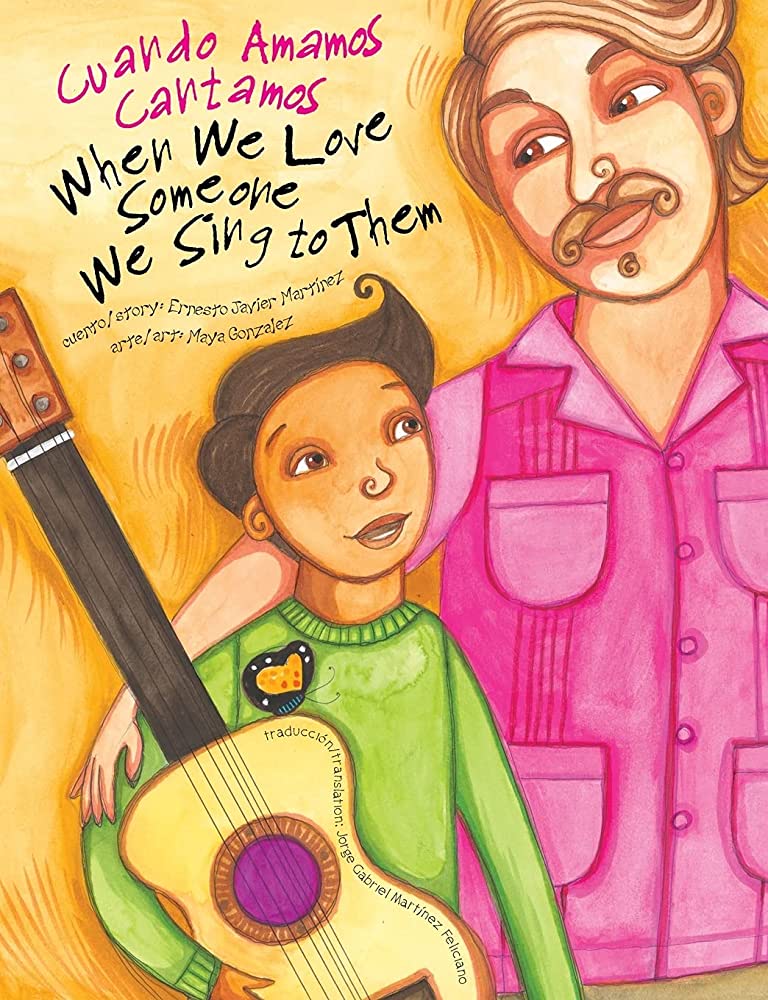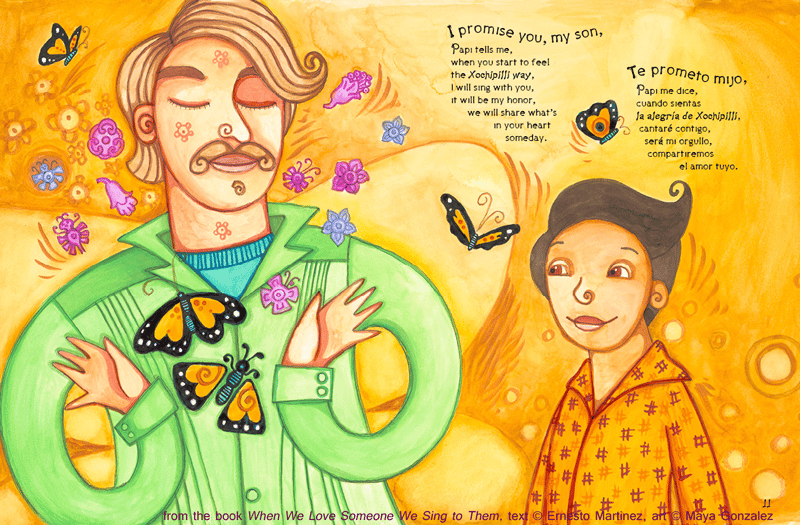
Inclusive Children's Book Teaching Guide
When We Love Someone We Sing To Them/Cuando Amamos Cantamos
What is this book about?
When We Love Someone We Sing to Them/Cuando Amamos Cantamos reframes a cultural tradition to include the LGBTQ+ experience.
We learn about the Mexican tradition of serenata (singing to family members and loved ones) through a small boy who naturally assumes that the tradition includes him and his experience.
Watch a tradition expand as limitations are lifted to include everyone, all the way back to Xochipilli, the Mesoamerican deity of creativity, dance and song.
By sharing this book with your early learners, you can bring tradition and inclusion into the conversation and reassure LGBTQ+ young ones that they belong and always have.
This charming tale also fosters pride in young children of Mexican heritage as it celebrates the culture and history of LGBTQ+ families. The story and the supplemental content at the back of the book are presented in Spanish and English.
Who is depicted in this book?
- A child who is LGBTQ+
- Children or adults who transcend gender stereotypes
What early childhood themes and concepts does this book explore?
- How parents and caregivers love, support and teach children
- Emotions (the different ways that love feels and looks)
- Music and words as artistic expression; serenatas as expressions of love and history
- The shared activities of the main character and his amigo
How does this book support anti-bias education?
When We Love Someone We Sing to Them/Cuando Amamos Cantamos supports children as they develop caring and loving relationships and teaches them about the diversity of emotional expression.
The author's intent is to represent boys who love boys within the tradition of serenatas, a popular Mexican courtship tradition that has largely excluded them. In the story, the main character’s father validates and supports the love that the main character has for another boy: "He says that gardens like mine, even through droughts, have persisted. He says that gardens like mine have always existed." The book illustrates how a parent can empower a child to claim and express his identity.
Depending on how the book is shared or used—and the developmental level of the children—the images and text may be used to support the following core goals from the book, Anti-Bias Education for Young Children and Ourselves:
Diversity—Teachers will promote each child’s comfortable, empathetic interactions with people from diverse backgrounds so that children will express comfort and joy with human diversity, use accurate language for human differences, and form deep, caring connections across all dimensions of human diversity.
Activism—Teachers will cultivate each child’s ability and confidence to stand up for oneself and for others in the face of bias so that children will demonstrate a sense of empowerment and the skills to act, with others or alone, against prejudice and/or discriminatory actions.
How can this book be used to meet early childhood learning standards?
For all ages
For children from birth to age three
Teaching suggestion: Point out and model ways that the father in the book shows care and love for his son by smiling, hugging, playing music, singing, etc. Show how the father demonstrates that adults are safe people to go to for soothing and encouragement.
What Illinois Early Learning Guideline does this meet for children from birth to age three?
Developmental DomainSelf-Regulation
Standard: Emotional RegulationChildren demonstrate the emerging ability to identify and manage the expression of emotion in accordance with social and cultural contexts.
Indicators for children:
- Seeks out caregiver through physical actions (7–18 months)
- Seeks caregiver support when feeling overwhelmed by emotion (21–36 months)
Teaching suggestion: Point out how and where the boys in the story play together so that the youngest children can react to, point at, or name what is familiar to them.
What Illinois Early Learning Guideline does this meet for children from birth to age three?
Developmental DomainLanguage Development, Communication and Literacy
Standard: Early LiteracyChildren demonstrate interest in and comprehension of printed materials.
Indicators for children:
- Points to familiar pictures and actions in books (16–24 months)
- Recites part of book from memory (21–36 months)
For preschoolers (ages three to five)
Teaching suggestion: Play some traditional Mexican serenatas for the children (such as Hector Hugo’s Jardin de Mariposas) and ask them to discuss how the songs make them feel. Talk about ways that they express love for their friends and family members. As a teacher, consider how these expressions are rooted in culture and represent commonalities and differences among children.
What Illinois Early Learning and Development Standards does this meet for preschoolers?
The Arts Standard25AInvestigate, begin to appreciate, and participate in the arts.
Benchmark 25.A.ECc:
Music: Begin to appreciate and participate in music activities.
Teaching suggestion: The illustrations in the text use line, shape and color to convey ideas and feelings. Ask the children to discuss what they notice in the illustrations, why the illustrator drew the characters/events in the way they did, and how the illustrations make them feel.
What Illinois Early Learning and Development Standards does this meet for preschoolers?
Language Arts Standard2DEstablish personal connections with books.
Benchmark 2.D.ECa:
With teacher assistance, discuss illustrations in books and make personal connections to the pictures and story.
Teaching suggestion: Use this book as an opportunity to challenge young children’s assumptions about loving relationships and friendships. For example, preschoolers may already assume that a boy cannot love another boy. It is critical to interrupt these biases early on when children express them, as they can be well-established before kindergarten.
What Illinois Early Learning and Development Standards does this meet for preschoolers?
Social/Emotional Development Standard31ADevelop positive relationships with peers and adults.
Benchmark 31.A.ECb:
Recognize the feelings and perspectives of others.
See inside this book.

What other resources are available?
In a special section for adults at the end of When We Love Someone We Sing to Them/Cuando Amamos Cantamos, the author and illustrator introduce themselves and discuss the creation and meaning of the book. They also describe the serenata tradition and some of the concepts presented in the story, as well as related film projects, including a film about a serenata between boys. The lyrics for this serenata are included in this section as well. The song "Jardin de Mariposas" was written for the author’s film project and can be found online.
Read an interview with the author on the Pride and Less Prejudice website.
